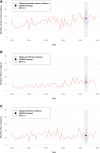Ransomware Cyberattack Associated With Cardiac Arrest Incidence and Outcomes at Untargeted, Adjacent Hospitals
- PMID: 38605720
- PMCID: PMC11008621
- DOI: 10.1097/CCE.0000000000001079
Ransomware Cyberattack Associated With Cardiac Arrest Incidence and Outcomes at Untargeted, Adjacent Hospitals
Abstract
Objectives: Healthcare ransomware cyberattacks have been associated with major regional hospital disruptions, but data reporting patient-oriented outcomes in critical conditions such as cardiac arrest (CA) are limited. This study examined the CA incidence and outcomes of untargeted hospitals adjacent to a ransomware-infected healthcare delivery organization (HDO).
Design setting and patients: This cohort study compared the CA incidence and outcomes of two untargeted academic hospitals adjacent to an HDO under a ransomware cyberattack during the pre-attack (April 3-30, 2021), attack (May 1-28, 2021), and post-attack (May 29, 2021-June 25, 2021) phases.
Interventions: None.
Measurements and main results: Emergency department and hospital mean daily census, number of CAs, mean daily CA incidence per 1,000 admissions, return of spontaneous circulation, survival to discharge, and survival with favorable neurologic outcome were measured. The study evaluated 78 total CAs: 44 out-of-hospital CAs (OHCAs) and 34 in-hospital CAs. The number of total CAs increased from the pre-attack to attack phase (21 vs. 38; p = 0.03), followed by a decrease in the post-attack phase (38 vs. 19; p = 0.01). The number of total CAs exceeded the cyberattack month forecast (May 2021: 41 observed vs. 27 forecasted cases; 95% CI, 17.0-37.4). OHCA cases also exceeded the forecast (May 2021: 24 observed vs. 12 forecasted cases; 95% CI, 6.0-18.8). Survival with favorable neurologic outcome rates for all CAs decreased, driven by increases in OHCA mortality: survival with favorable neurologic rates for OHCAs decreased from the pre-attack phase to attack phase (40.0% vs. 4.5%; p = 0.02) followed by an increase in the post-attack phase (4.5% vs. 41.2%; p = 0.01).
Conclusions: Untargeted hospitals adjacent to ransomware-infected HDOs may see worse outcomes for patients suffering from OHCA. These findings highlight the critical need for cybersecurity disaster planning and resiliency.
Keywords: cardiac arrest; cyberattack; cybersecurity; outcomes; ransomware.
Copyright © 2024 The Authors. Published by Wolters Kluwer Health, Inc. on behalf of the Society of Critical Care Medicine.
Conflict of interest statement
Drs. Malhotra, Dameff, Wardi, and Pearce received support for article research from the National Institutes of Health (NIH). Dr. Malhotra received funding from Zoll, Jazz, Eli Lilly, and Livanova. ResMed gave a philanthropic donation to the University of California San Diego. Dr. Longhurst receives support from the Joan and Irwin Jacobs Center for Health Innovation. Dr. Dameff is supported by Career Development Award (1-K08-EB032477) from the National Institute of Biomedical Imaging and Bioengineering. Dr. Wardi’s institution received funding from the NIH (K23 GM146092) and National Foundation of Emergency Medicine; he received funding from Northwest Anesthesia. Dr. Sell received funding from Zoll. Dr. Pearce received funding from the National Heart, Lung, and Blood Institute (T32). The remaining authors have disclosed that they do not have any potential conflicts of interest.
Figures
References
-
- Jarrett MP: Cybersecurity—a serious patient care concern. JAMA 2017; 318:1319–1320 - PubMed
-
- Landi H: Scripps Health Was Attacked by Hackers: Now, Patients Are Suing for Failing to Protect Their Health Data. Fierce Healthcare. 2021. Available at: https://www.fiercehealthcare.com/tech/following-ransomware-attack-scripp.... Accessed July 5, 2023
-
- Smart W: Lessons Learned Review of the WannaCry Ransomware Cyber Attack. 2018. Available at: https://www.england.nhs.uk/wp-content/uploads/2018/02/lessons-learned-re.... Accessed August 8, 2023


